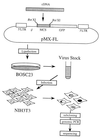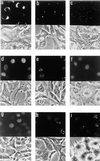A method to identify cDNAs based on localization of green fluorescent protein fusion products
- PMID: 10716735
- PMCID: PMC16192
- DOI: 10.1073/pnas.97.7.3062
A method to identify cDNAs based on localization of green fluorescent protein fusion products
Abstract
We previously established a high-efficiency, retrovirus-mediated expression cloning method. Using this system, we now have developed an expression cloning method (FL-REX; fluorescence localization-based retrovirus-mediated expression cloning) in which cDNAs can be isolated based on the subcellular localization of their protein products. Complementary DNAs generated from mRNA using random hexamers were fused to the cDNA of green fluorescent protein (GFP) in the pMX retrovirus vector. The resulting cDNA-GFP fusion library was transfected into retrovirus-packaging cells, and the derived retroviruses were used to infect NIH 3T3 cells. Infected cells then were screened to identify cDNAs of interest through the subcellular localization of the GFP-fusion products. Using FL-REX, we have identified 25 cDNAs, most of which showed reasonable subcellular localization as GFP-fusion proteins, indicating that FL-REX is useful for identification of proteins that show specific intracellular localization.
Figures


References
Publication types
MeSH terms
Substances
Associated data
- Actions
LinkOut - more resources
Full Text Sources
Other Literature Sources
Molecular Biology Databases

